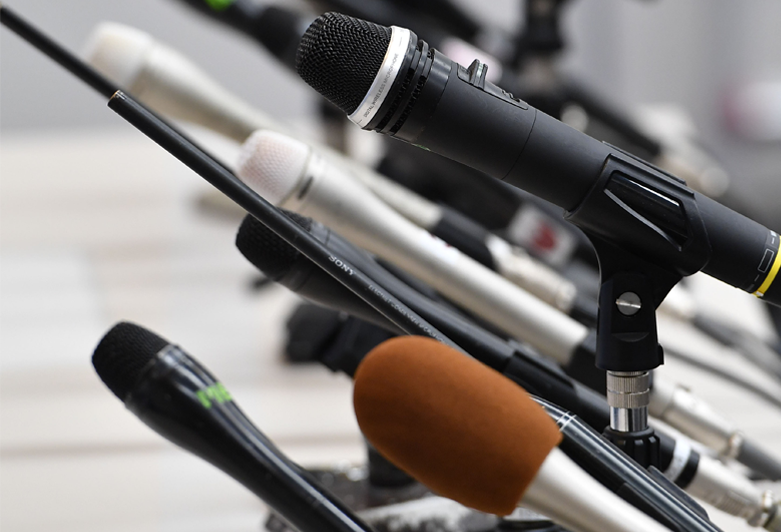CEATEC AWARD special website

Your innovative ideas change the world
We are looking for your innovative ideasthat will open up the future.
The CEATEC AWARD recognizes and awards highly innovative and outstanding technologies
from academic, technological, marketability and future potential perspectives.
What is the CEATEC
AWARD?
The committee evaluates submissions based on academic and technical merits, market potential, and future prospects, and recognizes those that demonstrate exceptional innovation and excellence.
Exhibitors wishing to apply should complete the "CEATEC AWARD 2025 Application Form" (No. 18) and submit it by August 26, 2025, at 5:00 PM (JST).



Types of Awards
CEATEC AWARD 2025 Minister's Award
Minister's
Award

We award projects that are evaluated as contributing most to the advancement of the digital society in the future, such as the advanced utilization of information and communications, networks, data, AI, and IoT technologies in the digital society, the provision of services using these technologies, and the digital utilization in local communities.
Minister's
Award

We award projects that are evaluated as contributing most to the future development of the digital society, such as those that utilize advanced technologies such as AI, quantum computing, and robotics to create new value in the digital society and economy, promote the resolution of issues and transformation in lifestyles, society, business, and industry, as well as innovative manufacturing, services that utilize IoT, or cross-sectional technological development that promotes the digital transformation of industry.
Digital Agency
Award

We award projects that are evaluated as contributing most to the creation of a prosperous and resilient society for the future, through mechanisms and services that ensure that no one is left behind in the digital society and that enable the realization of diverse happiness for each individual.
CEATEC AWARD 2025 Category Awards
Category
This category targets proposals for new technologies, products, services, software, applications, solutions, and business models that contribute to the sustainable maintenance and prosperous development of industry, business, society, and daily life, and that are evaluated as having advanced nature, concrete feasibility, and social contribution in line with the realization of Society 5.0.
Generation
Category
This category recognizes start-up companies and universities/research institutions that have developed advanced technologies, products, services, software, applications, or business models and are working to bring them to market. Entries will be evaluated based on their practical feasibility, contribution to society, technical excellence, marketability, and other factors.
Category
This category is open to proposals for technologies, products, services, software, applications, solutions, business models, etc. that are co-created by companies from diverse industries and business sectors based on unique themes with the aim of realizing Society 5.0. The winners will be selected based on their advanced nature and contribution to the future society.
Category
This category is open to exhibitors from outside Japan. The winners will be selected based on their practical feasibility and contribution to society.
Mobility
Category
Among the exhibits by startup exhibitors at this year's Japan Mobility Show 2025 (October 30 (Thu) to November 9 (Sun), Tokyo Big Sight), we will present the CEATEC AWARD 2025 to those that are evaluated based on their practical feasibility and contribution to society.
Participation Benefits

Influence through media
- ・Provision of a list of award winners to the media
- ・Announcement of award results at a press briefing and distribution of press releases
- ・Follow-up media coverage during the event
- ・Pre-event promotion through exhibition at a press conference (for applicants only)

Attracting visitors to the venue
- ・Publication of award results on the official website
- ・Display of award results at the central entrance (TBD)
- ・Display of award certificates and trophies at the award-winning product exhibition

Sales, Promotion,
and Advertising Effects
- ・Permission to use the CEATEC AWARD 2025 logo mark on sales and promotional tools, advertisements, etc. for the award-winning products.
Inclusion in the CEATEC 2025
Select Collection
CEATEC 2025 will publish the "CEATEC 2025 Select Collection" based on the application information for the CEATEC AWARD 2025.
- ・The "CEATEC 2025 Select Collection" will be published in booklet form (printed version) and on the CEATEC 2025 official website based on the information provided in the application form. The booklet version is intended for media and government officials, while the official website is for visitors.
- ・The information will be made public starting October 1 (planned), which will help guide visitors to the booth at the Makuhari Messe venue.
- ・Please register the following information for the Select Collection in the application form: "Application Title," "Application Description/Overview (including intended use, features, technologies, and characteristics, within 200 characters)," "Photo/Image," and "Company/Organization Logo."
- *Please submit one photo/image that can be publicly disclosed as of October 1.
- *Eligible applicants are those who have applied for the CEATEC AWARD and have expressed a desire to be featured.There are no fees associated with publication.
- *Please note that there will be no confirmation or proofreading by the applicant prior to publication.


(Per application)
- Excluding exhibitors in the Next Generation Park and Global Park
All exhibitors
Application fee: JPY 55,000 (including consumption tax)
- For Next Generation Park and Global Park exhibitors
Application fee: JPY 11,000 (including consumption tax)
- ・Download the application form from the link below, fill in the required information, and upload it to the exhibitor-only website. Click here to download the application formClick here to download the application form
- ・Please refer to the explanatory video for exhibitors to access the exhibitor-only website. Please note that if you are a joint exhibitor, such as a pavilion exhibitor, you will need to apply through the parent exhibitor.
- ・When submitting the application form, you may submit up to two items: images or photos that clearly illustrate the specific concept of your application, along with technical details (PDF: A4 format, up to 10 pages), and video materials. Please upload each item separately and include the upload URL in the application form.
- ・There is no limit to the number of applications you may submit. If applying for multiple projects, please submit a separate application form for each project.
- ・Applications are limited to exhibitors at CEATEC 2025.
All applications will be reviewed by the judges based on the attached materials.
2. First Round of Judging
Based on the results of the document review, the judges will select the candidates for the Minister's Award and the Department Awards.
3. Final Review Meeting (Minister's Award and Category Awards)
A final review meeting will be held for the candidates for the Minister's Award and Category Awards selected at the preliminary review meeting, where the applicants will give presentations on their projects and answer questions, and the winners of the Minister's Award and Category Awards will be decided.
- Presentation of Candidate Projects and Q&A
- ・The candidates for the Minister's Award and the candidates for the departmental awards selected at the first review meeting will be invited to attend the final review meeting. They will give presentations explaining their projects, followed by a question-and-answer session with the review committee members.
- ・Details of the review meeting will be provided to the applicants of the candidate projects that pass the first review after the first review meeting.
- ・The Minister's Award and Category Award will be selected by the review committee at the "Minister's Award and Category Award Final Selection Meeting" after the candidate case presentations and Q&A session, and the Minister of Internal Affairs and Communications Award, Minister of Economy, Trade and Industry Award, Minister of Digital Affairs Award, and Category Awards will be selected.
4. Announcement of Minister's Award and Departmental Award: October 7 (Tuesday)
The Minister's Award and Category Award will be announced on the official website, at a press conference, and in a press release.
5. Minister's Award Ceremony/Category Award Ceremony
Details will be announced separately.
- ・Applications must not infringe on any other patents, etc., and must not be subject to any ongoing disputes.
- ・If any false information or other misconduct is discovered after the application has been accepted, or if any actions that undermine the purpose of this program are taken, the application will be invalidated.
- ・During the judge period, the information provided in the application will only be disclosed to the review committee, and we will take great care in handling the information.
CEATEC 2025
Press Conference and Exhibition
In conjunction with the CEATEC 2025 press conference for members of the press, we will set up an exhibition space to showcase the products and services of participating companies and organizations.
This exhibition will be a valuable opportunity to promote your company to the media prior to CEATEC. We are now accepting applications from companies and organizations wishing to participate in the exhibition.
*Media will be guided to the exhibition space after the press conference (10:00 a.m. - 11:00 a.m.).


- This exhibition is entry-based and subject to a fee (JPY165,000 per entry, including consumption tax). It is announced that if you would get the CEATEC AWARD (Ministry Award/Category Award), the exhibition fee will not be charged.
Regardless of whether you win the award, you must apply in advance if case you participate in the Pre-exhibition. - If you wish to apply for the CEATEC AWARD and participate in this exhibition, please check the appropriate box on the application form.
- Multiple applications are permitted per company or organization, but exhibition applications must be submitted separately for each product or project.
- Companies or organizations that have applied to exhibit will be requested to submit detailed exhibition content via a dedicated entry form at a later date.
Request regarding the CEATEC AWARD 2025 Minister's Award
This year's Minister's Award ceremony will include a simple exhibition in conjunction with the presentation of certificates and trophies.
Therefore, we kindly request all recipients of the CEATEC AWARD 2025 Minister's Award to confirm the following details and cooperate with us.
Date and time: October 14 (Tue) 6:30 PM
Location: Palace Hotel Tokyo / 1-1-1 Marunouchi, Chiyoda-ku, Tokyo

CEATEC AWARD Selection Committee
Japan Electronics and Information Technology Industries Association (JEITA) *CEATEC 2025 Organizing Organization
Japan Information and Communications Network Industry Association (CIAJ) *CEATEC 2025 Co-organizing Organization
Japan Software Association (SAJ) *CEATEC 2025 Co-organizing Organization
Japan Automobile Manufacturers Association, Inc. (JAMA) *CEATEC 2025 Supported Organization
Tribeat Co., Ltd.

